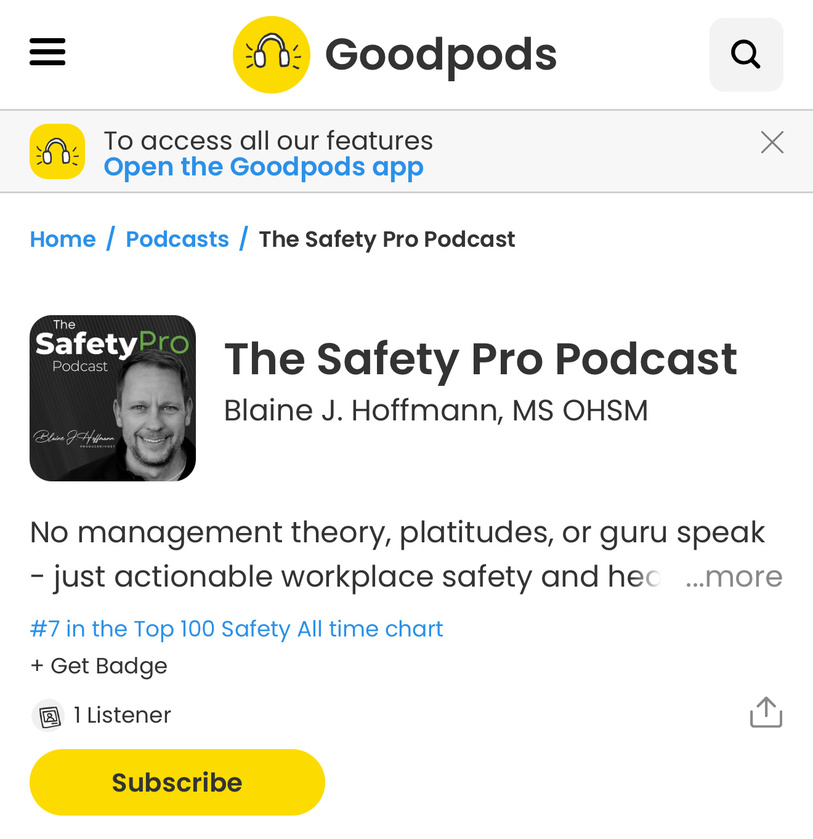It goes without saying that workplace safety training is vital to protect employees, comply with regulations, reduce costs, boost morale, and enhance reputation. Yet so many companies have a casual approach to this important activity. Many just throw together canned materials based on what they think is needed. You must develop a well-documented safety training plan for your business. A safety training plan outlines employees' training needs and requirements to work safely and prevent workplace accidents and injuries.
Furthermore, this comprehensive plan is essential for any company, regardless of size or industry. Here are a few reasons why:
- Enhances job performance: A comprehensive training plan ensures that employees have the knowledge and skills to perform their jobs effectively and efficiently, leading to higher productivity, better quality work, and fewer mistakes or errors.
- Improves employee satisfaction: Training and development opportunities can help employees feel more valued and invested in their work, leading to higher job satisfaction, engagement, and retention.
- Reduces turnover and costs: Employees who receive adequate training and development are more likely to stay with the company long-term, which can help reduce turnover rates, which can be costly in recruitment, training, and lost productivity.
- Ensures compliance and safety: Many industries have specific regulations and safety requirements to which employees must adhere. A comprehensive training plan can ensure that employees understand and comply with these requirements, which can help avoid costly fines, lawsuits, or workplace accidents.
- Fosters a culture of learning: A comprehensive training plan sends a message to employees that the company values continuous learning and development, which can create a culture of learning where employees are encouraged to seek out new knowledge and skills, which can lead to innovation and growth for the company.
By implementing a comprehensive safety training plan, businesses can create a safer and healthier work environment for employees while improving the bottom line.
Training Needs Assessment
As mentioned, a safety training plan is a comprehensive document that outlines the training needs and requirements for employees to work safely and prevent workplace accidents and injuries. But how do you implement such a plan? Where do you begin?
A critical part of your safety training plan requires you to first know what training is needed and who needs it, so you must conduct a training needs assessment. I know what you are thinking, "but I already know what OSHA topics require training," which may be accurate, but not all OSHA topics apply to every workplace or to every worker.
Conducting a workplace safety training needs assessment will tell you exactly which safety standards, laws, codes, and industry best practices apply to your business. This assessment must be documented, identifying critical safety topics for training. This article will dive into various aspects of an overall safety training plan, but here are some basic steps needed to conduct a workplace safety training needs assessment.
- Determine the scope and purpose of the assessment: Define the objective and identify the specific job tasks and hazards to assess.
- Identify the employees you will assess: Identify the employees who perform the job tasks with the identified hazards and those who may be at risk of hazards.
- Identify the training needs: Determine what knowledge and skills are required for employees to perform their job tasks safely. Review company policies, regulations, and procedures for the identified hazards, and consult with experts.
- Develop assessment tools: Identify or develop assessment tools to collect information about employees' current knowledge and skills related to the identified hazards. Tools include surveys, interviews, industry practices, legal research, and observations.
- Collect data: Use the assessment tools to collect data from the employees identified for assessment. Analyze the data to determine the gaps in knowledge and skills related to the identified hazards.
- Develop a training plan: Based on the data analysis, develop a training plan that addresses the identified knowledge and skill gaps. Consider the types of training methods that will be most effective, such as classroom training, hands-on training, or online training.
- Implement the training: Implement the training plan and evaluate its effectiveness. Determine if the training has improved the knowledge and skills of employees related to the identified hazards.
- Monitor and update the training: Monitor the effectiveness of the training over time, and update the training as needed based on changes in job tasks or hazards. Regularly assess the training needs of employees to ensure they remain up-to-date on safe work practices.
Identify Job Tasks and Hazards
Let's break down number one from the previous list in even more detail before moving on. To identify the specific job tasks and hazards for a safety training needs assessment, you can follow these steps:
- Review job descriptions: Review job descriptions to determine the specific knowledge and skills required for each job, which can help identify any gaps in training or knowledge you may need to address.
- Conduct a workplace hazard assessment: A workplace hazard assessment involves identifying potential hazards in the workplace. Review company policies, regulations, and procedures related to safety, and consult with subject matter experts to identify hazards associated with specific job tasks.
- Review injury and illness data: Reviewing injury and illness data can help you identify the specific job tasks and hazards causing the most harm to employees. You can obtain this information from accident reports, workers' compensation records, and other data sources.
- Observe job tasks: Observe employees performing job tasks to identify hazards associated with those tasks, which can include identifying unsafe work practices, identifying potential hazards, and determining whether employees are following safety procedures.
- Consult with employees: Consult with employees who perform the job tasks to identify potential hazards associated with those tasks. Ask employees about any hazards they have identified and any safety concerns they may have.
- Review industry standards and best practices: Review industry standards and best practices related to specific job tasks to identify potential hazards and best practices for safe work practices.
- Consider the work environment: Consider the work environment, including factors such as lighting, noise, temperature, and ergonomics, which can affect employees' safety and health.
- Consider training methods: Consider the types of training methods that will be most effective for addressing the identified knowledge and skill gaps, such as classroom training, hands-on training, or online training.
By considering these steps, you can identify the specific job tasks and hazards associated with those tasks and those performing them so that they can be included in the safety training needs assessment.
Developing Training Plans
So now that you understand the job tasks and hazards, you can develop a safety training plan identifying your objectives and determine which topics to train on and whom to train. Following these steps can help you develop a safety training plan that addresses the identified safety training needs and achieves the desired safety training objectives.
- Define the objectives: Define the objectives of the safety training plan, such as improving employee knowledge and skills related to identified hazards, reducing the number of accidents, and increasing compliance with safety regulations.
- Determine the audience: Determine the audience for the training plan, including which employees need to receive training and their specific training needs.
- Identify the training topics: Based on the identified hazards and specific training needs, identify the topics you need to include in the training plan.
- Choose the training methods: Choose the training methods that will be most effective for delivering the training topics, such as classroom training, hands-on training, or online training.
- Develop the training materials: Develop the training materials, such as presentations, handouts, videos, or interactive activities, that you will use to deliver the training topics.
- Develop a training schedule: Develop a training schedule, including when and where the training will take place and how long each session will last.
- Determine the trainers: Determine who will deliver the training, such as internal trainers, external trainers, or subject matter experts.
- Develop an evaluation plan: Develop an evaluation plan to determine the effectiveness of the training, including measuring employee knowledge and skills before and after the training, as well as conducting surveys or focus groups to gather employee feedback.
- Implement the training plan: Implement it, deliver the content, and evaluate its effectiveness.
- Monitor and update the training plan: Monitor the effectiveness of the training plan over time, and update the training plan as needed based on changes in job tasks or hazards.

Identify Trainers
Now that we are gearing up to deliver content, we must address who will train the employees. To determine who will deliver the training, you can consider the following factors:
- Expertise: Look for individuals who have expertise in the training topics, such as subject matter experts or experienced trainers.
- Availability: Determine who can deliver the training based on their work schedule and other commitments.
- Experience: Consider the experience of potential trainers, including their experience delivering training and familiarity with the company and its operations.
- Communication skills: Look for individuals with strong communication skills, including conveying complex information clearly and concisely.
- Learning style: Consider the audience's learning style and look for trainers who can adapt their training style to meet the audience's needs.
- Internal vs. external trainers: Decide whether to use internal or external trainers. Internal trainers are typically employees already familiar with the company's operations and culture, while external trainers may have more specialized expertise in particular training topics.
As you can see, following these steps, one can identify who will deliver the training and ensure they have the expertise, skills, and experience to deliver it to the intended audience.
Prepare Trainers
Once you have identified your potential trainers, you must ensure they are prepared to train. A "train the trainer" program will equip internal trainers with the knowledge and skills they need to deliver training effectively to employees.
As previously mentioned, we want to ensure those delivering the training are qualified. We know from letters of interpretation that OSHA does not approve, certify, or endorse individual trainers or training programs. The employer must determine if a designated trainer meets the requirements and qualifications, as is the case under the HAZWOPER standard, for example. In other words, a trainer must demonstrate proficiency and understanding of the training topics and materials and have credentials and/or experience training others.
It is also important to remember that trainers must continue to attend continual professional development to maintain their knowledge and skills base.
As an instructor, attending various professional development and refresher courses allows you to gain new ideas from other instructors. Take advantage of any opportunities to be on industry and society committees to find new training materials, stay up-to-date on current trends and hazards, and determine what works best for the your operations - Drew Hinton, President/CEO of Arrow Safety, LLC
So what is a Train-the-Trainer program? What should be covered? The topics to include in a "train the trainer" session will vary depending on the training content and the experience of the trainers, but some key topics to consider include:
- Adult learning principles: Inform trainers on understanding how adults learn, the different learning styles, and the importance of engaging and motivating learners.
- Training techniques and methods: Provide an overview of different training techniques and methods, such as lectures, group discussions, role-playing, and hands-on exercises.
- Instructional design: Understanding how to develop effective training materials and how to sequence and structure content for maximum impact.
- Communication skills: Developing effective communication skills, such as active listening, questioning, and feedback.
- Facilitation skills: Understanding how to manage group dynamics, handle challenging participants, and create a positive learning environment.
- Assessment and evaluation: Learning how to assess employee knowledge and skills and evaluate the effectiveness of the training. More on assessments later.
- Safety regulations and best practices: Provide an overview of relevant safety regulations, policies/expectations, and best practices to ensure trainers have the necessary knowledge to deliver effective training.
- Technical skills: Providing training on any technical skills or tools that trainers may need to deliver content, such as PowerPoint, learning management systems, or other training software.
By covering these topics, trainers can develop the skills and knowledge they need to deliver effective training to employees and ensure that the training is engaging, relevant, and impactful. But not everyone considers each item when ensuring they have suitable trainers—especially number one on this list; adult learning principles. Let's dive deeper into this important topic.
Adult learning principles
As mentioned in the above list, adult learning principles are crucial to designing effective training programs that meet the needs of adult learners. In a "train the trainer" program, it is essential to include an overview of these principles to ensure that trainers understand how to engage and motivate learners.
Adult learners are more engaged when actively involved in the learning process, and it is designed with the learner in mind, considering their prior knowledge, skills, and learning preferences.
This learner-centered approach to training differs from a traditional approach, which often focuses on the content and the instructor. Instead, the learner-centered approach puts the learner at the center of the learning process and creates a more personalized and engaging learning experience. Therefore, the training program is interactive and participatory by design, with opportunities for learners to collaborate, discuss, and reflect on their learning
The learner-centered approach recognizes that learners come to training with different needs, preferences, and learning styles and that a one-size-fits-all approach is ineffective. By designing training programs tailored to the learners' needs, trainers can create a more engaging and effective learning experience that leads to better outcomes.
Adult learners are more motivated when they see the relevance of the training content to their job roles and responsibilities. Here are some examples of making training relevant to learners:
- Identifying learning goals: Before the training program begins, learners should be involved in identifying their learning goals. By setting their own goals, learners are more likely to be invested in the training program and see its relevance to their job and career.
- Contextualizing learning: Learners are likelier to engage with and retain information relevant to their job or career. So that learners can relate to and see the relevance of the training material to their job, design training programs to include real-world examples and scenarios
- Personalizing learning: Personalize training programs to meet the needs and interests of individual learners. Achieve this by allowing learners to choose their learning activities or projects or using adaptive learning technologies that adjust the training content based on learners' progress and preferences.
- Providing practice opportunities: Learners are more likely to retain information and develop new skills if they can practice and apply what they are learning. Training programs should allow learners to practice their new skills or knowledge in real-world scenarios relevant to their job.
- Providing feedback: Learners need feedback on their performance to understand what they are doing well and what they need to improve. Training programs should include regular feedback mechanisms that help learners monitor their progress and adjust their learning strategies.
- Encouraging collaboration: Learners can benefit from collaborating with their peers and learning from their experiences. Training programs should include opportunities for learners to collaborate on projects, discuss key concepts, and share their insights and ideas.
It’s all about making it relatable and as site-specific as possible. It doesn’t benefit you, as the instructor, or the students, to show videos and spend a lot of time discussing something that occurred across the country in a different industry in operations different from your own - Drew Hinton, President/CEO of Arrow Safety, LLC
By making training relevant to learners, trainers can increase engagement, motivation, and retention of the training material, leading to better learning outcomes and improved performance on the job.
Types of Learning Approaches to Consider
Here are some learning approaches you may want to consider adding to your train-the-trainer program:
Self-directed learning: Adult learners are more effective when they take responsibility for their learning and have the opportunity to reflect on their learning. Self-directed learning is a process in which individuals take responsibility for their learning and development. It involves setting goals, identifying learning needs, and choosing learning activities that meet them. Self-directed learners are proactive and take the initiative in their learning process rather than waiting for others to provide direction or guidance.
Self-directed learning can take many forms, including online courses, books, workshops, mentorship programs, and other learning experiences, use of videos, seminars, podcasts, blogs, social media, and online communities.
Self-directed learners must have strong self-management and time-management skills and the ability to identify their learning needs and find appropriate resources to meet them. They must also be able to evaluate their learning progress and adjust their learning strategies as needed.
Self-directed learning can be a powerful way for individuals to take control of their learning and development and achieve their personal and professional goals. This approach is best used after other onboarding and essential job training.

Experience-based learning: Adult learners have a wealth of experience you can leverage to enhance their learning. Including opportunities to share their experiences and apply their new knowledge to real-world situations is essential. Experience-based learning involves learning by doing and often involves hands-on activities, simulations, or real-life experiences. Here are some examples of experience-based learning:
- Internships and apprenticeships: These programs allow learners to gain real-world experience in a specific field or industry.
- Simulations: Simulations allow learners to experience real-world situations in a safe and controlled environment. For example, flight simulators allow pilots to practice flying without risking real-world consequences.
- Field trips: On-site trips can provide learners hands-on experience in a specific industry or field. For example, safety specialists can visit a site to see how to execute daily standard work.
- On-the-job training (OJT): OJT involves learning while performing job tasks and can effectively develop new skills and knowledge.
- Project-based learning: Project-based learning involves completing a project or task requiring learners to apply their knowledge and skills in the real world.
Experience-based learning can be an effective way for learners to develop new skills and knowledge and apply what they have learned in a real-world context. It can also be a more engaging and memorable way to learn than traditional classroom-based learning.
Problem-based learning (PBL): Adult learners are often motivated by solving real-world problems, so designing training programs that include opportunities to solve problems and apply new knowledge and skills to practical situations is important. Here are some examples of problem-based learning:
- Chemical Spill: Present learners with a scenario involving a chemical spill to demonstrate all the steps needed to identify, notify, contain, clean up, and dispose of the chemical.
- Workplace Injury: Present learners with a mock injury case, asking them to walk through the entire response, treatment, reporting, and deep dive process.
- Injury Trends: Present learners with various trend results to have them think through how they would validate the trends, deep dive into their root causes, and develop mitigation strategies.
- Recordkeeping: Present learners with specific recordkeeping scenarios to help demonstrate these policies and how they apply to the workplace.
PBL can be an effective way for learners to develop critical thinking, problem-solving, and collaboration skills and apply their knowledge in a real-world context. It can also be a more engaging and memorable way to learn than traditional classroom-based learning.
Collaborative learning: Collaborative learning is a teaching method that involves learners working together in groups to solve problems, complete tasks, or develop new skills. Here are some examples of collaborative learning:
- Group projects: Students might be assigned to work in groups to complete a project or task that requires them to apply their knowledge and skills.
- Peer feedback and review: Learners might be asked to provide feedback on each other's work or to review and critique each other's writing, presentations, or other assignments.
- Think-pair-share activities: In a think-pair-share activity, learners are asked to think individually about a topic or question, pair up with a partner to discuss their thoughts, and then share their ideas with the rest of the class.
- Collaborative writing and editing: Trainers might ask learners to work together to write and edit a document, such as a research paper or a group report.
- Group discussions and debates: Trainers might ask learners to participate in discussions or debates on a specific topic or issue.
- Collaborative problem-solving: Learners might be presented with a real-world problem or scenario and asked to work together to find a solution.
One item that is not listed here is online learning or computer-based training. Online, self-paced computer-based training can be valuable to an effective safety and health training program. However, the use of online training by itself would not be sufficient to satisfy OSHA training requirements unless that training contains interactive and hands-on components.
To be effective, training must result in mastery of the training material (for example, safe work practices or the safe and appropriate use of tools and personal protective equipment). Online training without interactive and hands-on components would not meet this goal - Training Letter of Interpretation, OSHA
Training with no interaction, or delayed or limited interaction, between the trainer and trainee may halt or negatively affect a trainee's ability to understand and/or retain the training material. OSHA notes that one way for the employer to give workers this opportunity in the context of a computer-based program is to provide a telephone hotline so that workers will have direct access to a qualified trainer during the conduct of the online training.
Equally important is the provision of sufficient hands-on training because it allows an employee to interact with equipment and tools in the presence of a qualified trainer(s), allows the employee to learn or refresh their skills through experience, and allows the trainer to assess whether the trainees have mastered the proper techniques. Online training that does not provide workers with hands-on training would not comply with OSHA's worker training requirements.
Collaborative learning can be an effective way for learners to develop communication, work in groups to problem-solve, and learn from each other's perspectives and experiences. It can also be a more engaging and interactive way to learn than traditional classroom-based or online learning alone.
Assessment and Feedback Tools
The training program may also include self-assessment tools, feedback mechanisms, and opportunities for learners to track their progress and evaluate their learning. These tools and mechanisms help learners monitor their progress, identify improvement areas, and take ownership of their learning. Some examples of these tools and mechanisms include:
Self-assessment: Quizzes allow learners to independently test their knowledge and skills and identify areas where they need more practice or study. Here are some examples of self-assessment quizzes that trainers can use to support learning:
- Multiple-choice quizzes are common self-assessments that present learners with a question and several possible answers. Learners choose the correct answer and receive immediate feedback on their responses.
- True/false quizzes present learners with a statement and ask them to determine whether it is true or false. Learners receive immediate feedback on their responses.
- Matching quizzes ask learners to match a series of items, such as terms and definitions or pictures and descriptions. Learners receive immediate feedback on their responses.
- Fill-in-the-blank quizzes present learners with a sentence or phrase with a missing word or phrase. Learners fill in the missing word or phrase and receive immediate feedback on their response.
- Interactive online quizzes are more complex self-assessment quizzes that involve drag-and-drop exercises, simulations, or other interactive elements.
By incorporating self-assessment quizzes into a learner-centered training program, trainers can allow learners to evaluate their knowledge and understanding of the material.
Peer feedback: Peer feedback is a powerful learning tool that can help learners to receive constructive criticism, learn from others, and refine their skills. Here are some tips to consider when allowing for peer feedback during learning:
- Set clear expectations: Before beginning peer feedback, set clear expectations for learners. Let them know what you expect from them and what kind of feedback they should provide.
- Foster a positive and supportive environment: It's essential to create a positive and supportive environment where learners feel comfortable giving and receiving feedback. Encourage learners to provide constructive criticism and remind them to respect and support their peers.
- Provide guidelines and templates: Providing guidelines and templates can help learners to provide effective feedback. Consider providing learners with a rubric, a set of criteria to evaluate their peers' work or a template for providing feedback.
- Offer training and practice: It's important to offer training and practice in providing feedback. Consider providing learners with training on effective feedback, and offer opportunities for learners to practice giving feedback before they begin.
- Monitor the process: Monitor the peer feedback process to ensure it runs smoothly. Check in with learners regularly to gauge their progress and provide support and guidance as needed.
By incorporating peer feedback into a learner-centered training program, trainers can help learners to receive constructive criticism, learn from others, and refine their skills. With clear expectations, a positive environment, guidelines and templates, training and practice, and ongoing monitoring, learners can benefit greatly from peer feedback.
Trainer feedback: Trainer feedback provides learners with feedback from the instructor, which can help them to identify areas for improvement and to refine their skills. Providing feedback to learners is an essential part of the training process. Here are some tips to consider when giving feedback to learners:
- Be specific: Provide feedback that relates directly to the task or activity. Avoid general comments that are not helpful for learners to improve.
- Be objective: Provide objective feedback based on evidence rather than personal opinions or biases. Use data and examples to support your feedback.
- Be constructive: Provide feedback in a constructive and supportive way that helps learners to improve. Focus on strengths and areas for improvement, and suggest how learners can improve.
- Be timely: Provide feedback promptly, ideally soon after completing the task or activity. Delayed feedback can be less effective and may not be as helpful for learners to improve.
- Encourage self-reflection: Encourage learners to reflect on their performance and provide self-assessment, which helps them take ownership of their learning and development.
- Ask for feedback: Ask learners for feedback on the training and the feedback process, which helps to build a culture of feedback and continuous improvement.
By providing specific, objective, constructive, timely, and reflective feedback, trainers can help learners to improve their performance and achieve their learning goals.

Learning journals: Learning journals are a helpful tool for trainees to reflect on their learning experiences and track their progress. Here are some ways trainees can use learning journals:
- Reflect on learning: Trainees can use learning journals to reflect on what they have learned, what they have found challenging, and what they want to improve. Reflection can help trainees to make connections between what they are learning and their own experiences and think critically about their learning.
- Set goals: Trainees can use learning journals to set goals for their learning and track their progress. Trainees can stay motivated and focused on learning by setting goals and monitoring their progress.
- Take notes: Trainees can use learning journals to take notes on what they are learning, including key concepts, ideas, and examples. Taking notes can help trainees to stay organized and retain information more effectively.
- Document learning experiences: Trainees can use learning journals to document their learning experiences, including classroom activities, group discussions, and hands-on exercises, which can help trainees to remember what they have learned and identify areas where they need additional practice or support.
- Receive feedback: Trainees can use learning journals to receive feedback from their trainers and peers. By sharing their reflections and progress with others, trainees can receive feedback on their learning and identify areas for improvement.
Learning journals are a powerful tool to help trainees reflect on their learning, set goals, stay organized, and receive feedback. By incorporating learning journals into their training programs, trainers can help trainees take ownership of their learning and achieve their learning goals.
Performance Metrics: Key metrics can provide learners with objective feedback on their progress and performance. Here are some more examples of training performance metrics:
- Time to proficiency: This measures trainees' time to become proficient in the skills or knowledge. This metric can help trainers identify additional support areas to help trainees reach proficiency more quickly.
- Training completion rates: This measures the percentage of trainees who complete the training program. Low completion rates indicate the training program is not engaging or relevant to trainees.
- Retention rates: This measures the percentage of trainees who retain the knowledge or skills learned during the training program over time. High retention rates indicate that the training program was effective in helping trainees learn and retain the material.
- Cost per trainee: This measures the cost of delivering the training program per trainee. This metric can help trainers identify ways to optimize the training program and reduce costs while maintaining quality.
- Return on investment (ROI): This measures the financial return on the investment made in the training program. This metric can help trainers demonstrate the training program's value to stakeholders and justify continued investment.
- Learning transfer: This measures how trainees can apply the knowledge and skills learned during the training program to their jobs or other areas of life. This metric can help trainers identify areas where the training program can improve learning transfer.
By tracking these and other performance metrics, trainers can assess their training program's effectiveness and identify improvement areas. These metrics can also help trainers demonstrate the training program's value to stakeholders and justify continued investment in training and development.
Reflection exercises: Reflection exercises allow learners to reflect on their learning experiences, identify what they have learned, and apply that learning to their jobs. Reflection exercises can take many forms, including journaling, writing prompts, or guided discussions. Here are some ways you can use reflection exercises to support learning:
- Encourage self-awareness: Reflection exercises help learners to become more aware of their learning process, strengths, and areas for improvement.
- Foster critical thinking: Reflection exercises can help learners to analyze and evaluate their learning experiences and to think critically about how they can apply their learning to real-world situations.
- Support deeper learning: Reflection exercises encourage learners to go beyond surface-level learning and explore the material's underlying concepts and principles.
- Promote metacognition: Reflection exercises help learners develop their metacognitive skills, which are the skills needed to monitor, regulate, and evaluate their learning.
- Reinforce learning: Reflection exercises allow learners to review and reinforce their learning, which can help solidify their knowledge and skills.
Reflection exercises promote deeper learning, encourage critical thinking, and reinforce learning. By incorporating reflection exercises into a learner-centered training program, trainers can help learners become more self-aware, metacognitive, and effective.
Opportunities for discussion and collaboration: Opportunities for discussion and collaboration can help learners to identify areas where they need more support or guidance and to learn from their peers. There are several examples of ways that learners can collaborate, discuss, and reflect on their learning as part of a learner-centered training program. These examples include:
- Group discussions: Group discussions can be a powerful way for learners to share their experiences and perspectives, ask questions, and collaboratively engage with the material.
- Case studies: Case studies allow learners to apply their knowledge and skills to real-world situations and discuss and reflect on the outcomes.
- Peer reviews: Peer reviews allow learners to review and provide feedback on each other's work, which can help to improve their learning and performance.
- Role-playing exercises: Role-playing exercises allow learners to practice their skills in a simulated environment and to receive feedback from their peers.
- Collaborative projects: Collaborative projects allow learners to work together on a larger project or initiative, which can help to develop their teamwork and communication skills.
- Online forums or discussion boards: Online forums allow learners to collaborate and discuss the material in a virtual environment, which can be especially useful for remote or distributed teams.
- Reflection exercises: Reflection exercises, such as journaling or writing prompts, can help learners to reflect on their learning experiences, identify what they have learned, and apply that learning to their jobs.
By incorporating these collaborative, discussion-based, and reflective exercises into a learner-centered training program, trainers can create a more engaging and practical learning experience that leads to better outcomes.
Monitor Your Plan
Now let's move on to the post-launch phase of your safety training plan; monitoring. Many folks miss monitoring the training plan, which results in outdated materials, not keeping up on adequate trainers, creating knowledge gaps with learners, and introducing drift and potential error traps. To monitor and update a workplace safety training plan, you can follow these steps:
- Evaluate the effectiveness of the training plan, including the training materials, delivery methods, trainers, and overall impact on employee knowledge and behavior.
- Collect feedback from employees who received the training to identify areas for improvement and determine if additional training is needed.
- Analyze incident data to identify any new or emerging hazards and determine if changes to the training plan are needed to address these hazards.
- Review regulations and best practices related to workplace safety to ensure the training plan is up-to-date and meets current requirements.
- Update the training materials as needed to reflect any changes in hazards or regulations and to incorporate feedback from employees and trainers.
- Update the training schedule to ensure all employees receive the necessary training regularly and to accommodate any changes in job tasks or work environment.
- Provide ongoing training to employees to reinforce their knowledge and skills related to workplace safety.
- Communicate any changes to the training plan to employees, and ensure they are aware of any new hazards or regulations.
- Document the training provided to employees, including the topics covered, the date of training, and the attendees.
By following these steps, you can monitor and update the workplace safety training plan to ensure it remains effective and up-to-date and meets the needs of employees and the organization.
Conclusion
There is a lot to unpack in this article. To recap, we covered the following:
- Conducting a training needs assessment identifying job tasks and hazards.
- Developing a training plan to define objectives, topics, trainees, trainers, material, training approaches, etc.
- Discussed the importance of preparing trainers by creating a train-the-trainer program.
- Covered assessment and feedback tools/techniques.
- Discussed ways you can monitor your training plan moving forward.
A lot goes into successfully launching a comprehensive safety training plan. By systematically identifying which topics need training, which workers need training, developing qualified trainers, gaining feedback, and continuously monitoring the training plan progress, employees will have the knowledge and skills to perform their jobs effectively while promoting employee satisfaction, reducing turnover and costs, ensuring compliance and safety, and fostering a learning culture.

Blaine J. Hoffmann has been in the occupational safety & health industry for over 27 years. He is the producer and host of The SafetyPro Podcast and founded the SafetyPro Podcast Community Site.

Drew Hinton is President/CEO of Arrow Safety and has 10 years of experience as a career Firefighter/EMT/HazMat Officer in Louisville (KY) and 15 years as a safety professional.



















